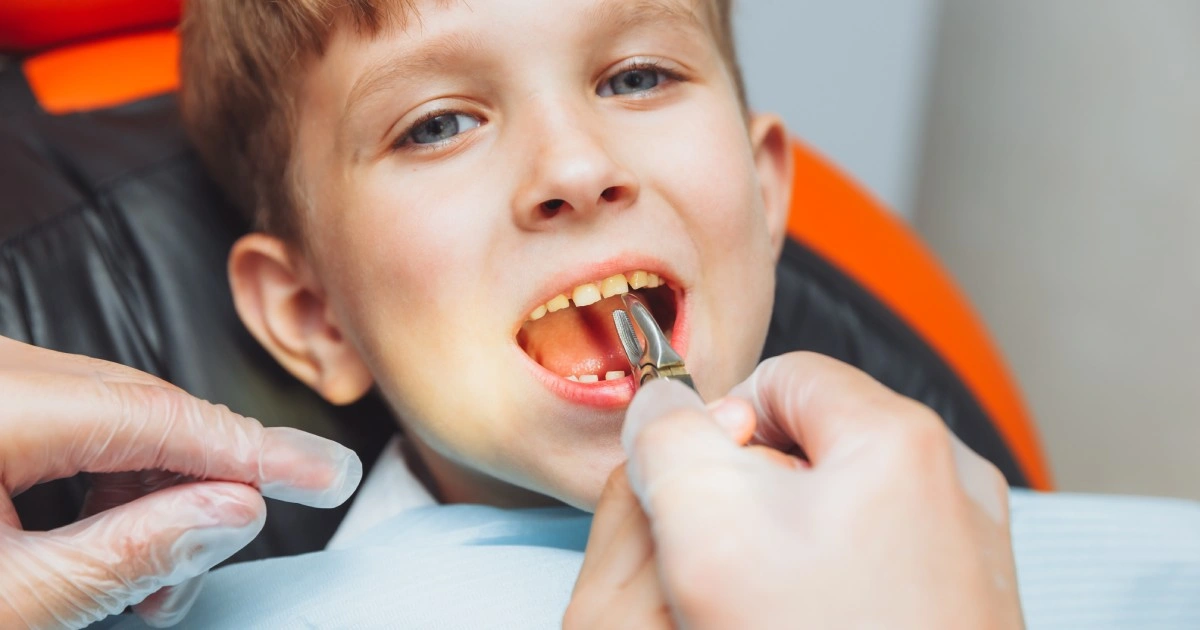Losing your child’s first tooth is incredibly exciting; most come out independently. There are times when baby teeth need a little help. Teeth may need to be extracted if damaged, badly decayed, or when baby teeth crowd adult teeth.
The situation isn’t as frightening as it seems. Children’s teeth extractions are usually noninvasive and shouldn’t worry you or your child.
At Solomon Kids Dentistry, we understand tooth extractions can be stressful for children and parents. However, with the right approach and preparation, you can help your child navigate this experience with minimal anxiety. In this comprehensive guide, we’ll explore effective strategies to support your child through their child’s tooth extraction journey, ensuring a positive dental experience that sets the foundation for lifelong oral health.
Understanding Your Child’s Fears
Before we dive into coping strategies, it’s important to recognize why your child might be anxious about tooth extraction:
- Fear of pain: Children often associate dental procedures with discomfort, even if they’ve never experienced it.
- Uncertainty about the procedure: The unknown can be scary, especially for young children who may not fully understand what’s happening.
- Concern about changes in appearance: Some children worry about how they’ll look after losing a tooth, particularly if it’s visible when they smile.
- Worries about recovery: Your child may be anxious about what to expect after the extraction, including potential pain or dietary restrictions.
- Past negative experiences: If your child has had a difficult dental visit, they may carry that anxiety forward.
- Fear of needles or medical instruments: The sight of dental tools can be frightening for children.
Acknowledging these fears can better address your child’s concerns and provide targeted support. Every child is unique, and their anxieties may stem from different sources. Taking the time to listen and understand your child’s worries is the first step in helping them overcome their fears.
Preparing Your Child for the Procedure
Open Communication
Start by having an honest, age-appropriate conversation about the upcoming tooth extraction. Explain why it’s necessary and what they can expect during the visit. Use simple, non-threatening language to describe the process. For example, you might say, “The dentist will help the wiggly tooth find a new home outside your mouth.”
Let your child ask questions and express feelings. Communicating openly with your child is important for building trust and addressing misconceptions. Be patient and willing to repeat information if needed, as children often need multiple explanations to understand new concepts fully.
Familiarize Your Child with the Process
Consider role-playing the dental visit at home. Stuffed animals or dolls can demonstrate the procedure, making it less intimidating for your child. This playful approach can help demystify the process and give your child a sense of control.
Also, consider reading children’s books about dental visits or watching age-appropriate videos that explain tooth extractions in a kid-friendly way. Many dental offices have resources available to help prepare children for their visits.
Choose the Right Time
Schedule the appointment when your child is typically well-rested and in good spirits. Managing the experience this way can reduce stress. Avoid scheduling during naptime or when your child is usually hungry. A well-rested, well-fed child is often more cooperative and less anxious.
Consider your schedule as well. Choose a time when you can be fully present and not rushed, as your calm presence will be a significant source of comfort for your child.
Techniques to Reduce Anxiety
Distraction Techniques
If possible, bring your child’s favorite toy, book, or handheld game to keep them occupied in the waiting room and during the procedure. Some dental offices have TVs or tablets for children to watch during treatment. Ask about these options when scheduling the appointment.
You can also play simple games like “I Spy” or tell stories to keep your child’s mind engaged on something other than the procedure. Singing soft songs or reciting favorite rhymes can also be soothing for younger children.
Breathing Exercises
You can teach your child simple breathing techniques to help them relax. Before the appointment, practice deep belly breathing together. To make this fun, have your child imagine blowing up a balloon in their belly and slowly letting the air out as they exhale.
Another effective technique is “square breathing”: inhale for a count of four, hold for four, exhale for four, and hold for four before starting again. This rhythmic breathing can be very calming and gives your child something to focus on during the procedure.
Positive Reinforcement
Be sure to commend your child’s courage and cooperation throughout the process. Use specific praise, such as “I’m proud of how you sat still in the chair” or “You did a great job following the dentist’s instructions.” This reinforces positive behaviors and builds your child’s confidence.
Consider offering a small, non-food reward after the procedure as positive reinforcement. This could be a special activity, a small toy, or extra screen time. Remember to emphasize that the reward is for their bravery and cooperation, not just for completing the procedure.
During the Tooth Extraction
Stay Calm and Supportive
Your child will look to you for reassurance. Be calm and offer words of encouragement throughout the procedure. Even if you’re anxious, try to project a calm confidence. Children are very perceptive and can pick up on their parents’ emotions.
Use a soothing voice and positive language. Instead of saying, “Don’t worry, it won’t hurt,” which can introduce the idea of pain, try saying, “You’re doing great. The dentist is helping your tooth.”
Hand Signals
Establish a simple hand signal system with your child and the dentist. This allows your child to communicate any discomfort or need for a break without speaking. For example, raising a hand could mean “I need a moment,” while a thumbs-up could mean “I’m okay.”
This system gives your child a sense of control over the situation and ensures they can communicate effectively even when their mouth is open. Practice these signals before the appointment so your child feels confident using them.
Comfort Items
Let your child hold a comfort item like a small stuffed animal during the procedure if allowed. The familiar object can provide emotional support and a sense of security. Some children find comfort in wearing their favorite shirt or bringing a special blanket.
After the Tooth Extraction
Follow Post-Extraction Care Instructions
Carefully follow the dentist’s instructions for post-extraction care. This may include:
- Gauze application: Show your child how to gently bite down on gauze to control bleeding.
- Ice pack use: Demonstrate how to apply an ice pack to reduce swelling, making it a game if possible.
- Dietary restrictions: Prepare soft, cool foods your child enjoys, turning meal planning into fun activities.
- Pain management: Administer any prescribed or recommended pain relief as directed by your dentist.
Involve your child in their care as much as possible, explaining each step and why it’s important. This can help them feel more in control of their recovery.
Monitor for Complications
While complications are rare, be vigilant for signs of infection or unusual bleeding. Contact Solomon Kids Dentistry if you have any concerns. Signs to watch for include:
- Persistent bleeding beyond the first day
- Severe pain that doesn’t improve with medication
- Swelling that worsens after the first 48 hours
- Fever or signs of infection
Explain to your child that it’s important to let you know if they experience any unusual symptoms or if the extraction site feels different.
Celebrate Their Bravery
After the procedure, celebrate your child’s courage. This positive association can help reduce anxiety for future dental visits. Consider having a special “brave day” celebration, which could include watching their favorite movie, playing a board game together, or any activity that makes them feel special.
To commemorate their achievement, create a “bravery certificate” or add a star to a reward chart. This tangible recognition can boost their confidence and create a positive memory associated with the dental experience.
Long-Term Strategies for Dental Health
Regular Dental Check-ups
Maintain regular dental check-ups to prevent future tooth decay and reduce the likelihood of needing extractions. Make these visits a positive routine by pairing them with a fun activity afterward, like a trip to the park or library.
Consistency is key in building a positive relationship with dental care. You should take your child to the dentist regularly so that he or she becomes familiar with the office environment, reducing anxiety.
Proper Oral Hygiene
Floss and brush your teeth at home regularly. Make these daily routines fun and engaging:
- Use a timer or play a two-minute song while brushing
- Let your child choose their toothbrush and toothpaste flavor
- Provide rewards for brushing and flossing consistently
- Use plaque-disclosing tablets occasionally to make thorough brushing a game
Explain how good oral hygiene can prevent the need for procedures like extractions in the future. This helps your child understand the importance of their daily habits.
Healthy Diet
Promote a balanced diet low in sugary foods and drinks to support dental health. Teach your child about “tooth-friendly” foods and involve them in grocery shopping and meal preparation. This can include:
- Choosing crunchy vegetables like carrots and celery, which help clean teeth
- Opting for water or milk instead of sugary drinks
- Selecting cheese and yogurt, which are good for tooth enamel
- Limiting sticky or chewy candies that can cling to teeth
Make healthy eating a family affair, setting a good example, and creating positive associations with tooth-friendly foods.
When to Seek Additional Support
If your child experiences severe dental anxiety, discuss sedation options with your dentist. Working with a child psychologist specializing in medical anxiety may be beneficial in some cases.
Signs that your child might need additional support include:
- Extreme fear or panic attacks at the mention of dental visits
- Refusal to open their mouth during dental exams
- Nightmares or sleep disturbances related to dental visits
- Physical symptoms like nausea or trembling when approaching the dental office
Remember, it’s okay to seek help. Many children benefit from professional support in overcoming dental anxiety, which can lead to healthier attitudes towards oral care in the long run.
Conclusion
While a tooth extraction can be a challenging experience for children, with proper preparation and support, it doesn’t have to be traumatic. By implementing these strategies, your child can establish positive attitudes toward dental care that will serve them well into adulthood.
At Solomon Kids Dentistry, we’re committed to providing a comfortable and supportive environment for your child’s dental needs. Our team is trained to work with anxious children, using gentle techniques and a patient-centered approach to ensure the best possible experience.
Every child is unique, so what works for one may not work for another. As you navigate this process, be patient with yourself and your child. With time, understanding, and the right support, your child can overcome their dental anxiety and develop a lifetime of good oral health habits.
If you have any questions or concerns about your child’s upcoming tooth extraction, don’t hesitate to reach out to our team. We’re here to support you and your child every step of the way. Together, we can make your child’s dental health journey as smooth and anxiety-free as possible, ensuring a lifetime of good oral health.





